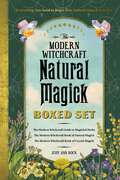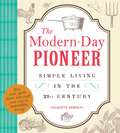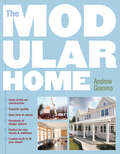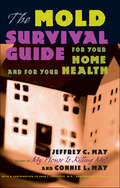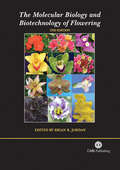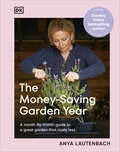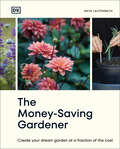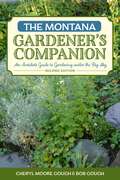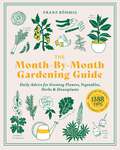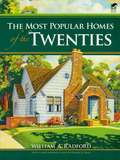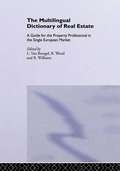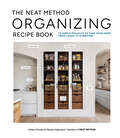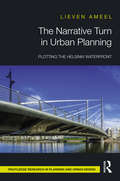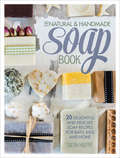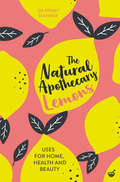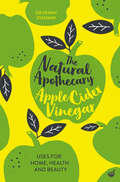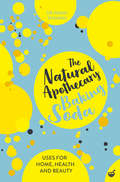- Table View
- List View
The Modern Witchcraft Natural Magick Boxed Set: The Modern Witchcraft Guide to Magickal Herbs, The Modern Witchcraft Book of Natural Magick, The Modern Witchcraft Book of Crystal Magick (Modern Witchcraft Magic, Spells, Rituals)
by Judy Ann NockEmpower your spells and rituals with natural elements from the magick of herbalism to the power of crystals with The Modern Witchcraft Magick Boxed Set.The Modern Witchcraft Natural Magick Boxed Set brings together three books to help new and experienced witches incorporate herbs, crystals, and other natural elements into their practice. This selection of titles from the Modern Witchcraft series provides guidance for all practitioners no matter their skill level, with step-by-step instructions, rituals, and spells. The boxed set includes: The Modern Guide to Magickal Herbs: This book includes information on which herbs are best for what kinds of spells, how to use herbs in divination and rituals, and step-by-step guides to making herbal bundles, potions, and sprays. The Modern Witchcraft Book of Natural Magick: This practical book includes methods to help you connect with Mother Earth and your own natural self with chapters focused on the elements, the sun and the moon, the plants and the earth, and more. The Modern Witchcraft Book of Crystal Magick: This comprehensive guide teaches you how to harness the power of crystals in your spells and rituals and includes a full-color inventory of fifty useful stones and gems. This boxed set is perfect for witches everywhere who are interested in utilizing natural magick in their practice.
The Modern-Day Pioneer
by Charlotte DenholtzRediscover the simple pleasures in life When was the last time you let the aroma of freshly baked bread fill your kitchen or felt the warmth of a heavy quilt on a cold winter night? In today's day and age, it's easy to get swept up in the whirlwind of convenience and forget what it's like to truly appreciate the simple things in life. The Modern-Day Pioneer celebrates these forgotten joys by showing you how to incorporate basic skills and living into your everyday life. Whether you're interested in growing your own fruits and vegetables, raising chickens for meat or eggs, crafting delicious meals from scratch, or creating and mending your own clothes and quilts, this book makes it easy to live a healthier and more sustainable life in the twenty-first century. Filled with step-by-step instructions and homegrown inspiration, you'll wonder how you ever lived without the sweet taste of locally harvested honey or the refreshing scent of homemade lavender soap.
The Modern-Day Pioneer
by Charlotte DenholtzRediscover the simple pleasures in life When was the last time you let the aroma of freshly baked bread fill your kitchen or felt the warmth of a heavy quilt on a cold winter night? In today's day and age, it's easy to get swept up in the whirlwind of convenience and forget what it's like to truly appreciate the simple things in life. The Modern-Day Pioneer celebrates these forgotten joys by showing you how to incorporate basic skills and living into your everyday life. Whether you're interested in growing your own fruits and vegetables, raising chickens for meat or eggs, crafting delicious meals from scratch, or creating and mending your own clothes and quilts, this book makes it easy to live a healthier and more sustainable life in the twenty-first century. Filled with step-by-step instructions and homegrown inspiration, you'll wonder how you ever lived without the sweet taste of locally harvested honey or the refreshing scent of homemade lavender soap.
The Modern-Day Pioneer: Simple Living in the 21st Century
by Charlotte DenholtzRediscover the simple pleasures in lifeWhen was the last time you let the aroma of freshly baked bread fill your kitchen or felt the warmth of a heavy quilt on a cold winter night? In today's day and age, it’s easy to get swept up in the whirlwind of convenience and forget what it's like to truly appreciate the simple things in life. The Modern-Day Pioneer celebrates these forgotten joys by showing you how to incorporate basic skills and living into your everyday life. Whether you're interested in growing your own fruits and vegetables, raising chickens for meat or eggs, crafting delicious meals from scratch, or creating and mending your own clothes and quilts, this book makes it easy to live a healthier and more sustainable life in the twenty-first century.Filled with step-by-step instructions and homegrown inspiration, you'll wonder how you ever lived without the sweet taste of locally harvested honey or the refreshing scent of homemade lavender soap.
The Modular Home
by Andrew GianinoModular homes are the perfect solution if you want to build a high-quality, customized home without undue expense or hassle. In this informative guide, Andrew Gianino helps you make the best choices throughout the modular building process, with suggestions for everything from choosing the right dealer and contractor to setting the specs, price, and schedule. Whether you’re looking for a cozy Victorian or want to add a personal touch to a wide ranch, there’s a modular home that will fit your tastes, lifestyle, and budget.
The Mold Survival Guide: For Your Home and for Your Health
by Jeffrey C. May Connie L. MayThe image was shocking: a couple wearing protective suits and masks in their own home! The accompanying USA Weekend story documented the mold-related headaches, fatigue, and respiratory problems that forced Melinda Ballard and Ron Allison to abandon their dream house, leaving all their possessions behind. Another family was so terrified that they had their mold-filled house torn down.Mold growth threatens property managers and builders, as well as home owners and renters. Legal settlements in some mold cases have reached the millions, and home insurance rates are skyrocketing. Some people argue that mold concerns are exaggerated; others are convinced that mold growth is destroying their health.In The Mold Survival Guide, a prominent indoor air quality professional teams up with a writing specialist to describe mold, to explain where and why it flourishes in homes, and to offer advice on how to eradicate mold while minimizing health risks. The book includes a chapter by two physicians who explain how exposure to mold can affect health.With clear scientific explanations and expert advice, The Mold Survival Guide is a valuable resource for anyone worried about a common household problem that can have serious consequences.
The Molecular Biology and Biotechnology of Flowering
by Brian R. JordanThis book explores three main themes: the external and internal regulation of flowering, floral development, and fertilisation and gametophyte development, and includes new chapters on the evolution of flowers, floral senescence and apomixis.
The Money-Saving Garden Year: A Month-by-month Guide to a Great Garden that Costs Less
by Anya LautenbachGarden better for less all year long with Anya Lautenbach the “Money-Saving Gardener”. With month-by-month advice on what to do when – from self-sown seedlings to spot, the best time to propagate different plants, and seasonal pruning jobs – Anya shows you how to keep your garden looking good without breaking the bank. Handy monthly plant lists, money-saving tips, propagation chart, and planting calendar guide you on your way. Embrace each season with timely projects to absorb you, garden highlights to enjoy, and notes on how to find happiness in your garden even in the depths of winter. Anya’s clear, practical yet mindful approach will help anyone grow a glorious garden while cutting costs.
The Money-Saving Gardener: Create Your Dream Garden at a Fraction of the Cost
by Anya LautenbachBeat the rising cost of living and transform your garden on a budget with Anya the Garden Fairy.The Money-Saving Gardener reveals the tips and tricks to keeping costs down without compromising on style or impact. Learn how to repurpose what you have and give new life to second-hand garden furniture; discover savvy cheats to keep hard landscaping costs low; and boost your plant collection for next to nothing with seed-saving and propagation hacks. Revealing the plants that will give you the best long-term value for money, tips for choosing the varieties that will thrive in your garden year after year, and projects for making the most of your propagated cuttings and seedlings, The Money-Saving Gardener proves that a stunning garden doesn&’t need to cost the earth or break the bank.
The Montana Gardener's Companion: An Insider's Guide to Gardening under the Big Sky (Gardening Series)
by Cheryl Moore-Gough Robert GoughThe Montana Gardener&’s Companion explains how to identify and address common shortcomings of Montana soils, including alkaline soils (the most common soil in Montana), acidic soils (found in some soils in the mountains and near Great Falls), and salty soils (found especially in eastern Montana and in areas west and northwest of Great Falls east of the Divide and in the far northeastern portions of Sheridan County). This book explains the different climates of eastern and western Montana, the effect of elevation on growing seasons, and how Montana gardeners can lengthen their growing seasons through careful plant selection, choosing the correct exposure, planting properly on slopes and using season-extending products.
The Month-by-Month Gardening Guide: Daily Advice for Growing Flowers, Vegetables, Herbs, and Houseplants
by Franz Bohmig&“Bursting with useful advice, especially for new gardeners.&” —Booklist To be a successful gardener, you need to know two things: how to do something and when to do it. Both concepts are thoroughly tackled in The Month-By-Month Gardening Guide. This comprehensive approach to gardening guides home gardeners—whether you are growing vegetables, flowers, or houseplants—through a year of growing. Throughout, the emphasis is on organic, wildlife-friendly techniques. By following the guidance detailed in this hardworking primer, you&’ll be well on your way to a beautiful and bountiful garden that will provide pleasure throughout the year.
The Mosaics of Roman Crete
by Rebecca J. SweetmanThis book examines the rich corpus of mosaics created in Crete during the Roman and Late Antique eras. It provides essential information on the style, iconography, and chronology of the material, as well as discussion of the craftspeople who created them and the technologies they used. The contextualized mosaic evidence also reveals a new understanding of Roman and Late Antique Crete. It helps shed light on the processes by which Crete became part of the Roman Empire, its subsequent Christianization, and the pivotal role the island played in the Mediterranean network of societies during these periods. This book provides an original approach to the study of mosaics and an innovative method of presenting a diachronic view of provincial Cretan society.
The Most Popular Homes of the Twenties (Dover Architecture)
by Daniel D. Reiff William A. RadfordBased on a rare 1925 catalog, this showcase of one of the most beloved eras of American architecture features floor plans, construction details, and photos of twenty-six homes. Styles range from English cottages and Spanish bungalows to Dutch colonials, New England farmhouses, and Italianate designs.More than 250 illustrations, and 21 color plates, complement the text, which contains detailed descriptions of exteriors and interiors. Supplementary articles explain how to convert porches into living space, install plumbing, and build garages. Other home-improvement suggestions offer tips on landscaping gardens and designing interior woodwork. Daniel D. Reiff, an authority on antique house-plan books, offers an informative introduction that places these authentic views of early-twentieth-century American architecture into a wider context.
The Multilingual Dictionary of Real Estate: A guide for the property professional in the Single European Market
by Bernadette C Williams R. Williams B. Wood L. van BreugelThe Multilingual Dictionary of Real Estate" is not simply a word-for-word dictionary of specialist and technical terminology. It offers explanations of terms which cannot be translated exactly or are liable to cause confusion. A supplementary section of the dictionary provides detailed notes as well as translations of particularly tricky terms. There are also invaluable sections outlining the real estate and planning systems in the different European countries, government and planning hierarchies and real estate associations throughout Europe.
The Mural at the Waverly Inn: A Portrait of Greenwich Village Bohemians
by Dorothy Gallagher Edward SorelSorel--whose caricatures and drawings regularly appear in The New Yorker and on its cover--chose forty Greenwich Village greats from the past 150 years to cavort in bacchanalian splendor. Each of the 40 makes a solo appearance in these pages alongside a charming, telling vignette of his or her life by Dorothy Gallagher, then appears in a foldout of the entire mural at the back of the book.
The NEAT Method Organizing Recipe Book: 70 Simple Projects to Take Your Home from Chaos to Composed
by Ashley Murphy Marissa Hagmeyer"A master class in functional style" (Billy Cotton), by the founders of NEAT Method In this one-of-a-kind organizing book, the projects are as simple as recipes, with &“ingredient&” lists and clear step-by-step directions. There are smart, stylish solutions for every room in the house, including quick wins that can be accomplished in just twenty minutes as well as larger overhauls that may take an hour or more, including: A &“drop zone&” for dirty shoes and sports gear at the garage door Compartmentalized drawers for everything from kitchen utensils to makeup to socks A color-coded bedroom closet A playroom kids will actually keep tidy And much more! The end result is transformative: By implementing solutions that emphasize beauty as much as function, you&’ll create a home that&’s well arranged, a true place of calm and simplicity.
The Narrative Turn in Urban Planning: Plotting the Helsinki Waterfront
by Lieven AmeelNarratives, in the context of urban planning, matter profoundly. Planning theory and practice have taken an increasing interest in the role and power of narrative, and yet there is no comprehensive study of how narrative, and concepts from narrative and literary theory more broadly, can enrich planning and policy. The Narrative Turn in Urban Planning addresses this gap by defining key concepts such as story, narrative, and plot against a planning backdrop, and by drawing up a functional typology of different planning narratives. In two extended case studies from the planning of the Helsinki waterfront, it applies the narrative concepts and theories to a broad range of texts and practices, considering ways toward a more conscious and contextualized future urban planning. Questioning what is meant when we speak of narratives in urban planning, and what typologies we can draw up, it presents a threefold taxonomy of narratives within a planning framework. This book will serve as an important reference text for upper-level students and researchers interested in urban planning.
The Nasty Bits: Collected Varietal Cuts, Usable Trim, Scraps, and Bones
by Anthony BourdainEssays from the long time chef and host of his travel show and author of Kitchen Confidential.
The Natural & Handmade Soap Book: 20 Delightful and Delicate Soap Recipes for Bath, Kids and Home
by Sarah Harper&“The natural products you can make from this book are not only kinder to your skin; they are also better for the planet&” (Soap Making Magazine, &“Top 6 Books for Soap Making&”). From nourishing oat soap bars to impressive rosebud soap cakes and fun soaps for kids, this book will inspire you to make beautiful handmade soap without all the chemicals found in commercial products. Sarah shows you how to master the two key techniques of handmade soapmaking—the traditional cold-process method and the fast and fun melt-and-pour method—and then demonstrates how to use these techniques to make fabulous soaps, shampoo bars, homemade washing powder, and even dishwasher soap bombs. Step-by-step photography and the author&’s insightful advice from years of experience teaching soapmaking makes every project achievable, guiding you effortlessly from start to finish. Packed with handy tips and an easy, approachable style, this is a beautiful book filled with practical projects so that anyone, including children, can make a variety of soaps they will be proud to use, display, and give away! &“This book shows that making soap is not just about the science, but can be another kind of art as it allows makers to bring out their creativity in the process.&” —Bangkok Post &“A fabulous book for anyone interested in all things soap.&” —Sustainable(ish)
The Natural Apothecary: Tips for Home, Health and Beauty
by Dr. Penny StanwayA pocket guide to harnessing the power of lemons to use as a natural remedy, beauty aid and household resource.From face masks and hand creams to cleaning products and cold–and-flu remedies, the scent and flavour of lemon have long been used by manufacturers of home and beauty products to imbue their products with the zesty freshness which this citrus fruit is associated worldwide, and it’s little wonder why… Packed with vitamin C, an aid to digestion and linked to sparkling eyes and skin, this humble little fruit is packed with goodness that, with a little know-how, can easily be harnessed to allow you to bypass the chemicals and produce your own all-natural products for home, health and beauty.With our increasing awareness of reducing exposure to chemicals and the importance of keeping things natural, as well as the ever-growing realization of the environmental impact of disposable plastic packaging, there has never been a better time to go back to basics, embrace all-natural ingredients and regain control of what we are putting in and on our bodies. The Natural Apothecary: Lemons opens by exploring the benefits of lemons and looks at how to grow your own at home. The following pages are broken into sections on home, health and beauty, containing over 40 simple recipes for all-natural, home-made products that allow you to utilize the vitality of lemons with ease; make a bruise balm infused with lemon zest, a fragrant hand lotion for soft and youthful skin, or a chemical-free cleaning solution guaranteed to leave your home sparkling.
The Natural Apothecary: Tips for Home, Health and Beauty (Nature's Apothecary Ser. #1)
by Dr. Penny StanwayA pocket guide to harnessing the power of apple cider vinegar to use as a home remedy, beauty aid and household resource.Derived from the world’s most popular fruit, apple cider vinegar has long been revered for its health giving benefits. Linked with weight loss, regulating blood sugar and gut health, as well as its many beauty benefits and practical uses around the home, this super ingredient is a must-have in homes the world over.With our increasing awareness of reducing exposure to chemicals and the importance of keeping things natural, as well as the ever-growing realization of the environmental impact of disposable plastic packaging, there has never been a better time to go back to basics, embrace natural ingredients and regain control of what we are putting in and on our bodies. The Natural Apothecary: Apple Cider Vinegar opens by exploring the different types of apple cider vinegar and the importance of using natural, unfiltered varieties ‘with the mother’. The following pages are broken into sections on home, health and beauty, containing over 40 simple recipes for all-natural, home-made products that allow you to utilize the power of apple cider vinegar with ease; make a soothing balm to ease sunburn, an astringent blemish cream for a clear complexion, or make your own wax polish infused with apple cider vinegar to leave your home sparkling.
The Natural Apothecary: Tips for Home, Health and Beauty (Nature's Apothecary Ser. #3)
by Dr. Penny StanwayA pocket guide to harnessing the power of bicarbonate of soda to use as a home remedy, beauty aid and household resource.Not just for cakes, bicarbonate of soda has long been recognised as a hero ingredient for anyone looking to make their own eco-friendly cleaners and beauty products. Made up of tiny crystals, bicarb’s natural structure makes it the perfect gentle abrasive for home cleaning, and its natural antacid properties are ideal for tackling heartburn or creating antibacterial cosmetics at home.With our increasing awareness of reducing exposure to chemicals and the importance of keeping things natural, as well as the ever-growing realization of the environmental impact of disposable plastic packaging, there has never been a better time to go back to basics, embrace natural ingredients and regain control of what we are putting in our homes and on our bodies. The Natural Apothecary: Bicarbonate of Soda opens by exploring what bicarbonate of soda is made up of, and how it can be both naturally occurring and manufactured. The following pages are broken into sections on home, health and beauty, containing over 40 simple recipes for all-natural, home-made products that allow you to utilize the power of bicarbonate of soda with ease; make a soothing drink to ease indigestion, an all-natural exfoliating scrub to smooth your skin, or a simple but effective stain remover to leave your clothes looking like new.
The Natural Building Companion: A Comprehensive Guide to Integrative Design and Construction
by Jacob Deva Racusin Ace Mcarleton"Fun. Easy to Read...One of the best natural building books published in recent years."—Bill Steen, coauthor, The Straw Bale HouseNatural buildings not only bring satisfaction to their makers and joy to their occupants, they also leave the gentlest footprint on the environment. In this complete reference to natural building philosophy, design, and technique, Jacob Deva Racusin and Ace McArleton walk builders through planning and construction, offering step-by-step instructions on:• siting and site analysis• choosing materials• integrating basic structural considerations into a design• strategies for heating/cooling efficiency and moisture management• planning for acoustics• developing an integrative design• navigating budgeting, code compliance, and project management• creating the foundation, wall system, roof, and floors• selecting and making plasters and paints• evaluating options for mechanical and utility systems• protecting against fire and insects• integrating structures within landscape, climate, and human communities...and moreApplicable to building in climates that are cold and wet, hot and dry, or somewhere in-between, The Natural Building Companion provides the tools necessary to understand basic principles of building science, including structural and thermal engineering, and hydrodynamics. This guide offers thorough, up-to-date, and advanced installation details and performance characteristics of straw-bale, straw-clay, woodchip-clay, and cellulose wall systems, as well as earthen and stone wall systems and a variety of framing, roofing, flooring, mechanical system, and finishing options. This fully-illustrated volume informs professionals making the transition from conventional building, homeowners embarking on their own construction, or green builders who want comprehensive guidance on natural-building options.
The Natural Cleaning Handbook: Homemade Hand Sanitizers, Disinfectants, Air Purifiers, and More
by Natalie WiseMake sanitizers, soaps, and all your personal hygiene needs to kill germs and keep you virus-free! These days, dangerous viruses can suddenly become rampant, and bacteria can adapt to become antibiotic-resistant, so we must be extra-vigilant about our health. The Natural Cleaning Handbook keeps you clean, naturally, with homemade products that are healthy for you and your family. Start with the basics and work your way into every corner of your home . . . from tile grout to shower mold, how to clean lampshades to how to clean water bottles. Germ-killing recipes for cleaning nearly every surface in your home from the carpet to stuffed animals include: Hand sanitizing spray, gel, and foamAntibacterial hand and surface wipesAir purifying sprayLiquid hand soapAnd so much more! You&’ll also learn storage and organization secrets to keep your home clutter-free, how to manage your time and budget, and why some old-fashioned remedies are still the modern organic ways to keep home. Now is the time to get started.
